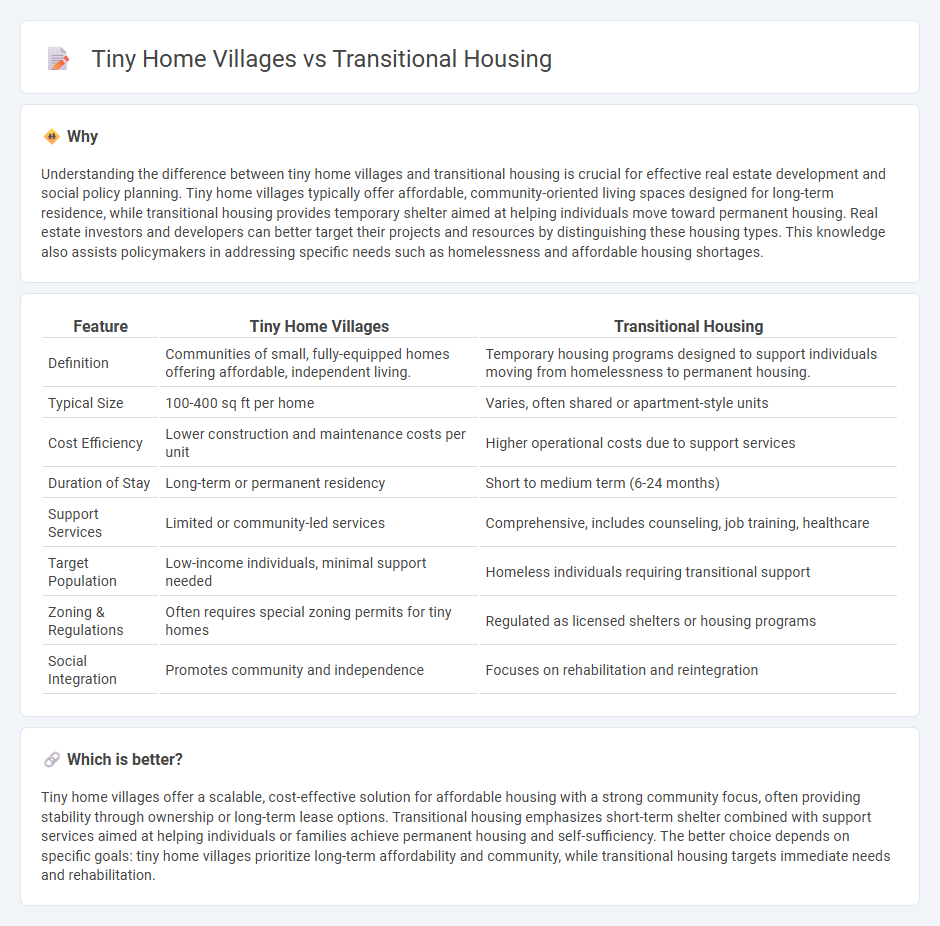
Tiny home villages offer compact, affordable living spaces designed for sustainability and community engagement, addressing housing shortages with innovative, space-efficient solutions. Transitional housing provides temporary accommodations focused on supporting individuals and families transitioning from homelessness to permanent residences, often including social services and case management. Explore the distinctive benefits and roles of tiny home villages and transitional housing in modern real estate development.
Why it is important
Understanding the difference between tiny home villages and transitional housing is crucial for effective real estate development and social policy planning. Tiny home villages typically offer affordable, community-oriented living spaces designed for long-term residence, while transitional housing provides temporary shelter aimed at helping individuals move toward permanent housing. Real estate investors and developers can better target their projects and resources by distinguishing these housing types. This knowledge also assists policymakers in addressing specific needs such as homelessness and affordable housing shortages.
Comparison Table
| Feature | Tiny Home Villages | Transitional Housing |
|---|---|---|
| Definition | Communities of small, fully-equipped homes offering affordable, independent living. | Temporary housing programs designed to support individuals moving from homelessness to permanent housing. |
| Typical Size | 100-400 sq ft per home | Varies, often shared or apartment-style units |
| Cost Efficiency | Lower construction and maintenance costs per unit | Higher operational costs due to support services |
| Duration of Stay | Long-term or permanent residency | Short to medium term (6-24 months) |
| Support Services | Limited or community-led services | Comprehensive, includes counseling, job training, healthcare |
| Target Population | Low-income individuals, minimal support needed | Homeless individuals requiring transitional support |
| Zoning & Regulations | Often requires special zoning permits for tiny homes | Regulated as licensed shelters or housing programs |
| Social Integration | Promotes community and independence | Focuses on rehabilitation and reintegration |
Which is better?
Tiny home villages offer a scalable, cost-effective solution for affordable housing with a strong community focus, often providing stability through ownership or long-term lease options. Transitional housing emphasizes short-term shelter combined with support services aimed at helping individuals or families achieve permanent housing and self-sufficiency. The better choice depends on specific goals: tiny home villages prioritize long-term affordability and community, while transitional housing targets immediate needs and rehabilitation.
Connection
Tiny home villages provide affordable, scalable solutions for transitional housing, addressing housing instability and homelessness. These communities offer essential amenities and foster a supportive environment that promotes social reintegration and long-term stability. The integration of tiny homes into transitional housing models optimizes land use and reduces development costs, accelerating housing accessibility.
Key Terms
Temporary Accommodation
Transitional housing provides structured, time-limited accommodation designed to support individuals or families moving from homelessness to permanent housing, often including case management and support services. Tiny home villages offer compact, cost-effective living spaces that prioritize community and autonomy, creating semi-permanent solutions with shared amenities for temporary shelter. Explore how these temporary accommodation models address housing insecurity and community integration challenges.
Communal Living
Transitional housing offers temporary accommodation with support services aimed at helping individuals move towards permanent housing, often emphasizing privacy and individualized care. Tiny home villages promote a sense of community through clustered small residences that encourage shared spaces and collective responsibility, fostering stronger social connections. Explore the differences to understand which communal living solution best suits varied housing needs.
Housing Stability
Transitional housing offers structured, time-limited accommodations designed to support individuals in moving from homelessness to permanent housing, emphasizing stability through case management and support services. Tiny home villages provide affordable, community-oriented living spaces that promote long-term housing stability by fostering peer support and self-sufficiency in small-scale, private dwellings. Explore how each model impacts housing stability and community integration for diverse populations by learning more about their unique benefits.
Source and External Links
Transitional Housing - Transitional housing is temporary housing for homeless individuals, providing support services to help them transition into permanent housing.
Transitional Housing Programs for Youth - Covenant House offers transitional housing programs for youth, providing a safe environment and supportive services to help them achieve stability.
CoC Program Components - Transitional Housing - The Continuum of Care (CoC) program includes transitional housing as a component that provides temporary housing and supportive services to help individuals achieve permanent housing.
 dowidth.com
dowidth.com